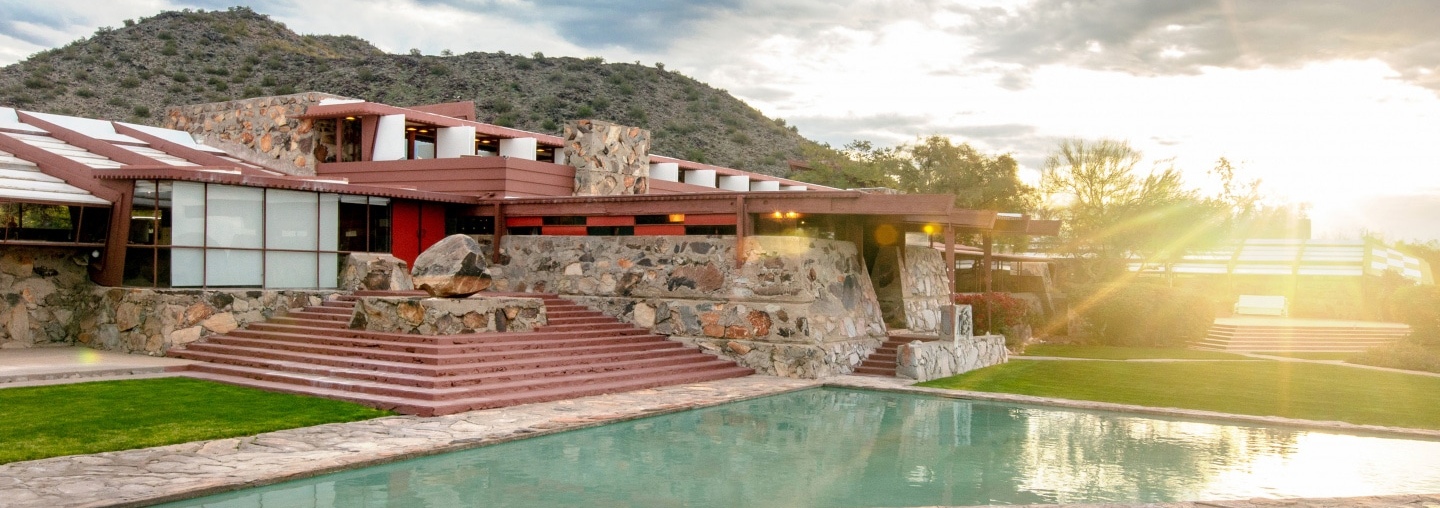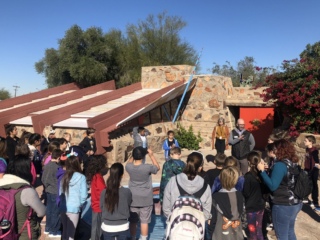
Frank Lloyd Wright’s Legacy Will Continue at Taliesin
Stuart Graff | Jan 31, 2020
In 1932, Frank Lloyd Wright created the Taliesin Fellowship, a community of apprentices and their families who lived, worked and studied with Wright first at Taliesin in Wisconsin and later also at Taliesin West in Scottsdale, Arizona. The program provided a total learning environment integrating all aspects of the apprentices’ lives with the intent of educating responsible, creative, and cultured human beings and building professionals.
Over time, and after the Frank Lloyd Wright’s (1959) and Olgivanna Lloyd Wright’s passing (1985), the Fellowship transformed into a more formal architectural firm and institution of learning, and most recently an accredited and fully independent small college, continuing to operate at the both Taliesin and Taliesin West.
This week the School of Architecture at Taliesin (SoAT) announced that it was unable to continue its operations, and would be closing its doors at the end of the spring semester in June. That decision could be made only by the school itself, and not by the Foundation, which is committed to finding ways to continue the legacy of education that Wright intended at his homes. Taliesin and Taliesin West remain open and thriving.
In the frenzy of the week’s announcement, some misinformation has been spread about how the decision to close the School came to be. Let’s set the record straight.
The Foundation is committed to keeping the two Taliesin campuses as living sites—where people make architecture and learn design from nature and the experience of working at an inspiring complex of buildings. We are the largest financial supporter of the School, donating over the last several years shared services and the free use of our campuses to facilitate SoAT’s health and support its growth—and to fulfill the commitment of preserving the Taliesins to maintain them as living sites that are at the heart of the community. But to fulfill this commitment for the future, the Foundation needs to have a solid plan for programs that do this work, precisely so we aren’t a pair of “mere house museums.”
“The Foundation is committed to keeping the two Taliesin campuses as living sites—where people make architecture and learn design from nature and the experience of working at an inspiring complex of buildings.”
SoAT is a completely separate entity from the Frank Lloyd Wright Foundation. It was made an independent organization because its accrediting body insisted that SoAT be capable of standing on its own, financially and academically, and no longer be dependent on the Foundation for support. Two representatives from the Foundation serve on the SoAT Board of Governors, so the Foundation has been conversant with the school’s operational challenges.

The Drafting Studio at Taliesin West
From the moment it became independent, SoAT built its budgets on aspirational but unrealistic projections for enrollment and fundraising that consistently weren’t met, leaving the School scrambling for operating and investment funds. The school later came back to the Foundation to request funding. We explained that we could not divert funds donated for preservation and other programs, since these were needed to keep the historically fragile buildings’ infrastructure (that serves the School and our visitors) in good service. The Foundation does not have large cash reserves, and like most cultural organizations in the Valley, it too has to borrow money to cover the summer months when revenues fall.
By mid-Spring of 2019, SoAT financial projections were so bleak that the SoAT Board made the decision to close its doors in August 2019 if student enrollment for the fall had not met a critical threshold by June 30, giving their students less than two months notice.
Therefore, it was not unanticipated when Dan Schweiker acknowledged to the Foundation leadership in early November that the School’s business model was, in his words, not sustainable. He asked us to extend the donation of our facilities at no cost for as long as two years, so that he could explore a new model that would include assembling a new board, eliminate accredited programs; move the School off the Taliesin campuses entirely or use them only part time; and/or merge the School back into the Foundation. Over many weeks thereafter, the Foundation asked Schweiker for guidance as to the School’s direction—without a meaningful response. In the meantime, the School’s President, Aaron Betsky, had tendered his resignation to be effective as of May—leaving the School with no defined business model and no leadership in addition to inadequate funding.
Finally, in a mid-January meeting at Taliesin West with Schweiker and SoAT Vice Chair Jacki Lynn and the Foundation leadership a plan was worked out based on a deep and shared commitment to maintain the dual legacy of cultural enrichment and professional education at Taliesin and Taliesin West. Contrary to what Schweiker and Lynn wrote in the press, that agreement provided for current second- and third-year students to complete their accredited degrees at the School and on our campuses; first-year students could accelerate their programs to graduate with accredited degrees as well. SoAT and the Foundation would also collaborate to create new programs to carry Wright’s legacy forward through hands-on education for architects, designers, and the interested public. And because these new programs wouldn’t require accreditation, we could save costs by bringing the School back into Wright’s Foundation. After a productive meeting, we stood together in my office and shook hands, congratulated one another on creating a successful path forward, which Schweiker and Lynn agreed to recommend and support before the SoAT Board.
But this agreed-upon plan was neither recommended nor supported by them. Instead, that Board was presented with yet another financially speculative program to try to save the School, offering hopeful dreams as an alternative to a concrete path to a sustainable future.
Rather than approve the agreed-upon plan and provide certainty for the students’ education and well-being, the SoAT Board chose to close the school and blame the Foundation for a failure to come to an agreement. To be clear: the Foundation sought a plan to transform the School for the 21st Century; the SoAT board voted instead to close the School.

Taliesin | Photo by Andrew Pielage
This decision to close was not communicated to the Foundation until we read the School’s press release. The School later came up with a new excuse for their decision: that the one-year extension to which they had agreed just one week earlier “was not financially feasible,” leaving unclear how they could have funded the two-year extension they proposed in November. Because SoAT is still struggling to figure out how to stay open through May, the Foundation has agreed again to donate shared services to reduce the School’s costs and ensure the students are as well served as possible under the circumstances.
The Foundation will return to extending Wright’s legacy of educating architects, keeping the life and the spirit of what he created front and center at both Taliesin and Taliesin West. That legacy includes continuing the training of architects , preservation specialists, design professionals, and the interested public—all in the same spaces where he created the world’s most celebrated architecture. Since the School’s announcement, we have welcomed and opened dialogues with potential partners to create a new and sustainable educational model rooted in Wright’s ideas, and we will announce those plans when they are finalized. And we will keep the two Taliesin campuses as the places that Wright wanted them to be: vibrant places where we advance the way we build and live, designing the future in harmony with the landscape, incorporating the arts in our work and our lives, building community. Wright said that “the mission of an architect is to help people understand how to make life more beautiful, the world a better one for living in, and to give reason, rhyme, and meaning to life.” That’s what we do at the Foundation he created, and we’ll do that for as long as we are able. ■
Stuart Graff is President & CEO of the Frank Lloyd Wright Foundation.



